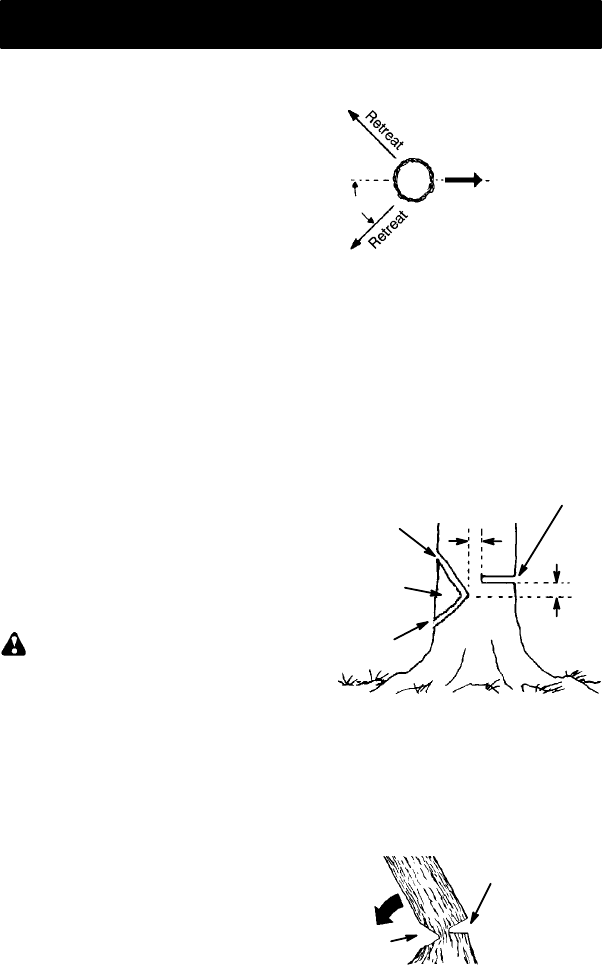
10
CUTTING METHODS
IMPORTANT POINTS
S Check chain tension before first use and
after 1 minute of operation. See CHAIN
TENSION in the ASSEMBLY section.
S Cut wood only. Do not cut metal, plastics,
masonry, non-wood building materials,
etc.
S The bumper spike may be usedas apivot
when making a cut.
S Stop the saw if the chain strikes a foreign
object. Inspectthesawandrepairpartsas
necessary.
S Keepthechainoutofdirtandsand. Evena
smallamountofdirtwillquicklydullachain
and increase the possibility of kickback.
S Practice cutting afew smalllogs usingthe
followingtechniques to getthe“feel”ofus-
ing your saw before you be gin a major
sawing op eration.
S Squeeze the throttle trigger and allow the
engine to reach full speed before cutting.
S Begin cutting with the saw frame
against the log.
S Keeptheengineat fullspeedtheentire
time you are cutting.
S Allowthechaintocutforyou.Exertonly
light downward pressure.
S Release the throttle trigger as soon as
the cut is completed, allowing the en-
gine to idle. If you run the saw at full
throttlewithoutacuttingload,unneces-
sary wear can occur.
S To avoid losing control when cut is com-
plete, do not put pressure on saw at end
of cut.
S Stop the engine before setting the saw
down.
TREE FELLING TECHNIQUES
WARNING:Donotcutnearbuildings
or electrical wires if you do not know the di-
rection of tree fall, atnight since you will not
be able to see well, or during bad weather
suchas rain,snow ,orstrong winds.as fallis
unpredictable.
Carefully plan your sawing operation in ad-
vance. You need aclear area all aroundthe
treeso you can have securefooting. Check
for broken or dead branches which can fall
on you causing serious injury.
Natural conditions that can cause a tree to
fall in a particular direction include:
S The wind direction and speed.
S The lean of the tree. The lean of a tree
might not be apparent due to uneven or
slopingterrain. Useaplumborleveltode-
termine the direction of tree lea n.
S Weight and branches on one side.
S Surrounding trees and obstacles.
Look for decay and rot. If thetrunk isrotted,
it can snap and fall toward the operator.
Make sure there is enough room for the tree to
fall. Maintain a distance of
2-1/2 tree lengths
from the nearest person or other objects. En-
gine noise can drown out a warning call.
Removedirt, stones, loosebark, nails, staples,
and wire from the tree where cuts are to be
made.
Direction of Fall
45_
Plan a clear retreat path
FELLING LARGE TREES
(15cmindiameterorlarger)
The notch method is used to fell large trees.
Anotchiscutonthesideofthetreeinthede-
sired direction of fall. After a felling cut is
made on the opposite side of tree, the tree
will tend to fall into the notch.
NOTCH CUT AND FELLING THE
TREE
S Make notch cut by cutting the top of the
notch first. Cut through
1/3 of thediameter
ofthetree.Nextcompletethenotchbycut-
ting the bottom of the notch. See illustra-
tion. Once the notch is cut remove the
notch of wood from the tree.
Notch
First cut
Second cut
Final cut here. 5 cm above
center of notch.
5cm
5cm
S After removing the wood from the notch,
makethefellingcutontheopposite sideof
the notch. This is done by making a cut
abouttwo inches higher thanthe centerof
the notch. This will leave eno ugh uncut
woodbetweenthefellingcutandthenotch
to form a hinge. This hinge will help pre-
ventthetreefromfallinginthewrongdirec-
tion.
Opening
of felling
cut
Closing
of notch
Hinge holds tree on stump and helps
control fall
NOTE: Before felling cut is complete, use
wedges to open the cut when necessary to
controlthedirectionoffall. Toavoidkickback
or chain damage, use wood or plastic
wedges, but never steel or iron wedges.

















